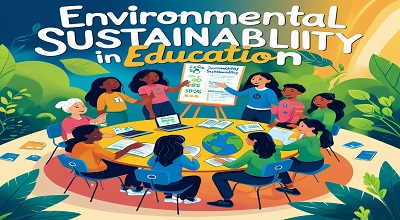Environmental Sustainability in Education
Environmental sustainability in education refers to integrating eco-friendly practices, awareness, and sustainable development principles into school curricula, policies, and infrastructure. It aims to equip students with the knowledge and skills needed to address environmental challenges such as climate change, pollution, and resource depletion.
With growing concerns about global warming and ecological degradation, educational institutions worldwide are adopting sustainability-focused programs. These initiatives range from green campuses to project-based learning on conservation.
The Importance of Environmental Education
Environmental education (EE) is crucial for fostering responsible citizenship and sustainable living. Key benefits include:
- Awareness: Students learn about environmental issues and their impact.
- Critical Thinking: Encourages problem-solving skills for sustainability challenges.
- Behavioral Change: Promotes eco-friendly habits like recycling and energy conservation.
- Career Opportunities: Prepares students for green jobs in renewable energy, conservation, and sustainability management.
According to UNESCO, Education for Sustainable Development (ESD) is essential for achieving the United Nations’ Sustainable Development Goals (SDGs).
Key Components of Sustainable Education
Sustainable education incorporates:
A. Curriculum Integration
- Incorporating sustainability topics in science, geography, and social studies.
- Project-based learning on renewable energy, waste management, and biodiversity.
B. Green School Infrastructure
- Solar panels, rainwater harvesting, and energy-efficient buildings.
- School gardens and green spaces for hands-on learning.
C. Community Engagement
- Partnerships with local environmental organizations.
- Student-led sustainability clubs and awareness campaigns.
D. Teacher Training
- Professional development programs on sustainability education.
Latest Trends in Environmental Sustainability in Education
A. Digital Sustainability Tools
- Apps for carbon footprint tracking (e.g., JouleBug, Oroeco).
- Virtual reality (VR) simulations for climate education.
B. Zero-Waste Schools
- Composting programs and plastic-free campuses.
- Reusable materials in classrooms.
C. Climate Literacy Programs
- Mandatory climate change education in countries like Italy and New Zealand.
- Student climate strikes and activism.
D. Green Certifications for Schools
- LEED-certified buildings.
- Eco-Schools program by the Foundation for Environmental Education (FEE).
Examples of Environmental Sustainability in Schools
A. Solar-Powered Schools
- Example: The Solar School Initiative in India provides solar energy to rural schools.
B. School Gardens & Farm-to-Table Programs
- Example: The Edible Schoolyard Project in the U.S. teaches students organic farming.
C. Recycling & Waste Reduction
- Example: Kamikatsu Zero-Waste Academy in Japan educates students on 100% recycling.
D. Eco-Friendly Transportation
- Example: Bike-to-school programs in the Netherlands reduce carbon emissions.
Case Studies: Successful Implementation Worldwide
A. Sweden’s Green Schools
- Sweden integrates sustainability into all school subjects, with energy-efficient buildings.
B. Costa Rica’s Environmental Curriculum
- Costa Rica mandates environmental education, leading to high reforestation rates.
C. Australia’s Sustainable Schools NSW
- Schools implement water-saving technologies and renewable energy projects.
Challenges and Solutions in Promoting Sustainability in Education
Challenges:
- Lack of funding for green initiatives.
- Resistance to curriculum changes.
- Limited teacher training.
Solutions:
- Government grants for sustainability projects.
- Teacher workshops on environmental education.
- Student-led advocacy for policy changes.
The Role of Teachers and Educators in Sustainability Education
Teachers play a vital role by:
- Incorporating sustainability into lesson plans.
- Encouraging student projects on environmental issues.
- Leading by example (e.g., reducing paper use, promoting recycling).
Government Policies and Global Initiatives
A. UN’s Sustainable Development Goals (SDGs)
- SDG 4.7 focuses on education for sustainable development.
B. The Paris Agreement & Climate Education
- Countries are integrating climate education into national policies.
C. National Green School Standards
- The U.S. Department of Education’s Green Ribbon Schools program.
Future of Environmental Sustainability in Education
The future includes:
- AI-powered sustainability learning tools.
- More global collaborations for climate education.
- Expansion of green schools worldwide.
Conclusion
Environmental sustainability in education is essential for creating a greener future. By integrating eco-friendly practices into schools, we empower students to become environmentally conscious leaders.
FAQs
Q1: What is environmental sustainability in education?
A1: It involves teaching students about eco-friendly practices and integrating sustainability into school operations.
Q2: How can schools promote sustainability?
A2: Through green infrastructure, sustainability curricula, recycling programs, and student-led initiatives.
Q3: What are some examples of sustainable schools?
A3: Solar-powered schools, zero-waste campuses, and schools with organic gardens.
Q4: Why is environmental education important?
A4: It raises awareness, fosters responsible behavior, and prepares students for future environmental challenges.
Q5: What global initiatives support sustainability in education?
A5: UNESCO’s ESD program, UN SDGs, and the Eco-Schools initiative.
Free Download: Teen Patti Gold MOD APK
